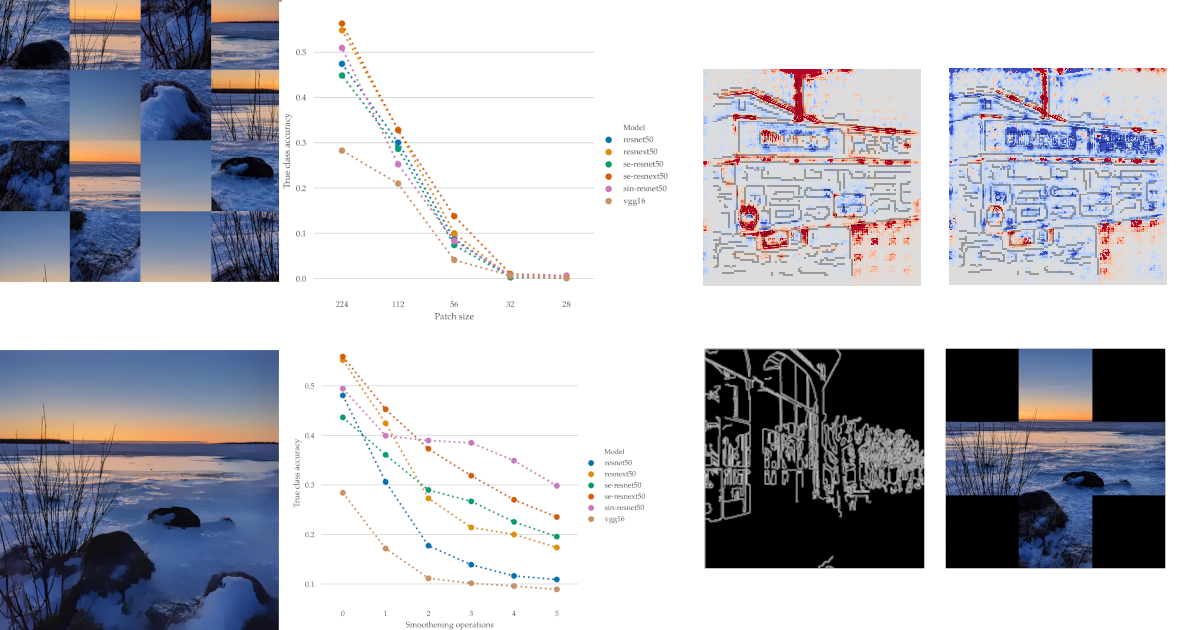Interactive notebooks and python code for my Master's Thesis: "The Role of Local Versus Global Features in Convolutional Neural Networks: A Comparison of State of the Art Architectures" at the University of Bamberg.
See this blog post for a brief summary of the thesis.
The current state of the art Convolutional Neural Networks (CNNs) were shown to oper- ate mostly by means of texture bias, whereas humans operate mostly on a shape bias. While the ImageNet challenge led to several milestones in the advancement of the field, recent publications question the suitability of ImageNet as a single criterion for evaluating a net- work’s performance. Additionally, since local features are sufficient to solve ImageNet comparatively well, ImageNet may be too "easy". In "ImageNet-trained CNNs are biased towards texture; increasing shape bias improves accuracy and robustness" Geierhos et al. [1] introduce stylized training – an augmentation technique that aims to constrain a network to learn shapes – in an effort to closer align CNNs with human vision. Geierhos et al. report close to human shape bias in their experiments. Amongst others, however, the small influence of stylized training on ImageNet-A, a dataset that should be solvable with a distinctive shape bias, calls these claims into question. This thesis aims to take a look inside the black box of a stylized trained ResNet-50, to test whether prerequisites for a shape bias are satisfied and if the network relies on shape re- gion in its classification process. Experiments show that a ResNet-50 trained on Stylized- ImageNet is only in some cases superior to a ResNet-50 trained on standard ImageNet regarding the prerequisites and that architectural refinements such as SE-ResNeXts might be a more promising alternative.
Due to the complex nature of the experiments, each step has its own notebbok.
- In 1_imagenet_boundingboxes a one easy to work with file with ImageNet's bounding boxes is created.
- 2_imagenette_boundingboxes adapts these bounding boxes to Imagenette and calculates the correct sizes of the boxes when resized to
256and then center cropped to224. - 3_canny_edges.ipynb creates a file that contains Canny edge coordinates for Imagenette using a custom
auto-cannyfunction. A reduced file with coordinates that lie within the respective bounding box is also created. These Canny edges later serve as a proxy for shape. - In 4_create_datasets the "smoothed", "scrambled", and "patched" datasets are created from Imagenette input files.
- The fifth step is concerned with the actual experiments and broken down in multiple sub-steps. First, 5_run_experiments runs the experiments on the created datasets. This does, however, not include the LRP and Canny edge experiments.
- 5.1. For the aforementioned experiments to work, the PyTorch models need to be converted to Keras using 5.1_pytorch2keras.
- 5.2. In 5.2_lrp_regions the LRP regions are calculated for both the Stylenet and the standard ResNet-50.
- 5.3. 5.4_lrp_canny combines the LRP coordinates with the Canny edge coordinates to check for overlaps.
- 6_experiment_analysis contains the general analysis of the experiments and the accompanying plots.
under construction
[1] Geirhos, Robert, et al. "ImageNet-trained CNNs are biased towards texture; increasing shape bias improves accuracy and robustness." arXiv preprint arXiv:1811.12231 (2018).
